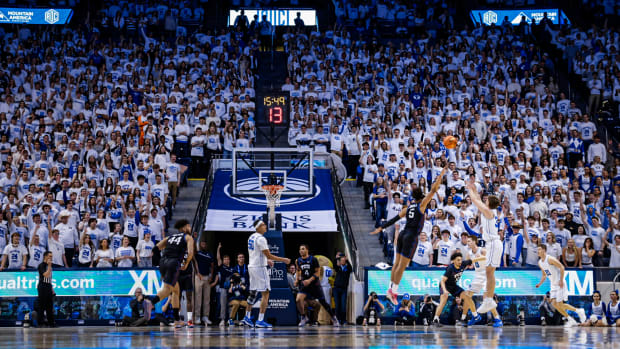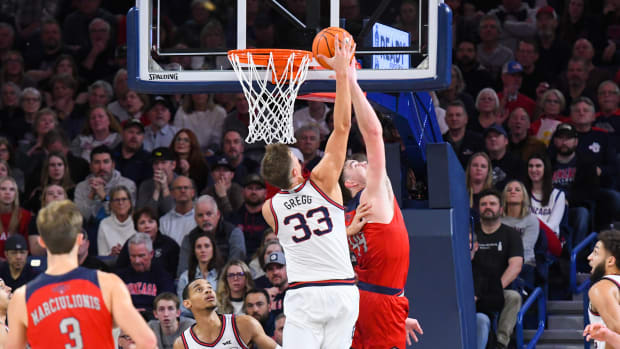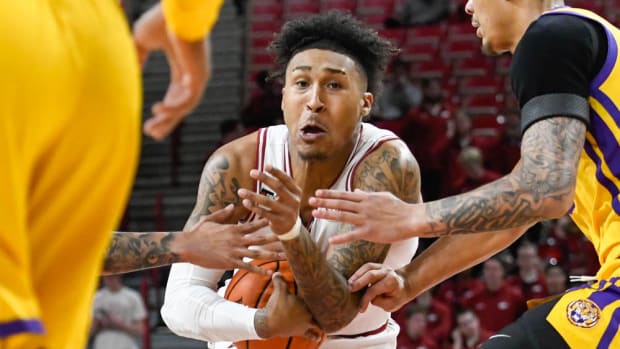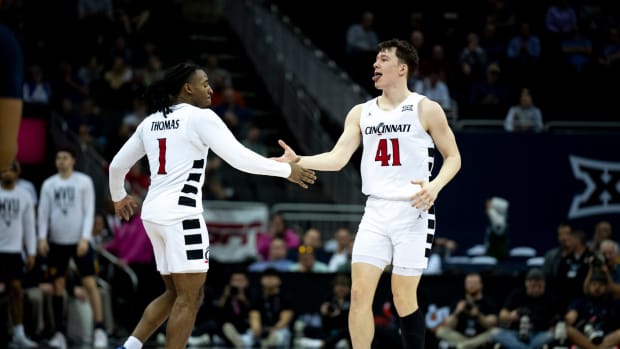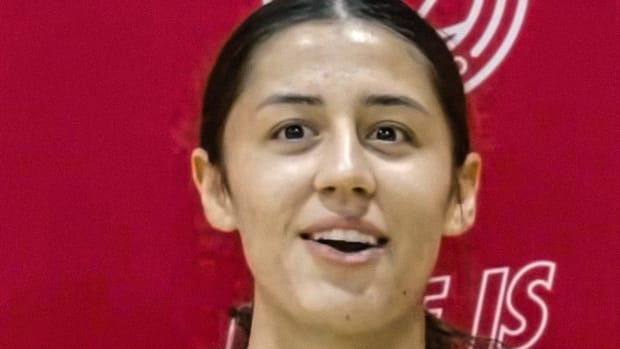Men’s College Basketball Season in Review: Pac-12
The 2020–21 men’s college basketball season is in the books, but it’s not too late to look back on the year that was. We’re going conference by conference within the high-major leagues to examine what went right—and what went wrong—along with a brief look ahead to 2021–22. We’ve done the ACC, Big 12, Big East and Big Ten. Next is the Pac-12.
On March 1, less than two weeks before Selection Sunday, the state of Pac-12 men’s basketball was fairly ho-hum. Colorado was the only team that appeared in the AP Top 25 poll (No. 24), with three others (USC, UCLA and Oregon) receiving votes. Oregon State had just improved to 13–11, though that likely failed to make waves outside of Corvallis.
Frankly, few beyond the Pac-12’s footprint were probably paying much attention to what was going on in the Pacific time zone. Then, four weeks later, no one in the college basketball world could look away.
The 2021 men's NCAA tournament played out like something from a Bill Walton fever dream, with the Pac-12 taking center stage all March long. An astounding three teams advanced to the Elite Eight, with UCLA returning the conference to the men's Final Four for the first time since 2017 and giving the Bruins their first appearance since 2008. Combine that with the all-Pac-12 women’s national title game, and it was a banner month for the Conference of Champions.
As we stare down the barrel of a long offseason, here’s a look back at a historic 2020–21 campaign, plus a peek ahead at the year to come.
Most important thing we learned: The Pac-12 can compete with the nation’s best
It had been a while since the Pac-12 played a relevant role in the NCAA tournament. Placing a team in the Final Four was certainly significant, but the manner in which the conference stole the show seemingly every day of the tournament was remarkable. USC, Oregon and Oregon State all beat Power 5 opponents in Kansas, Iowa, Tennessee and Oklahoma State by an average of 18.3 points to advance to the Sweet 16, while UCLA took down the top two seeds in its region (Alabama and Michigan) to reach the Final Four. The Pac-12’s relatively subpar performance in nonconference games in recent years has hindered its national reputation, but a run like this will go a long way in shaping how the league is viewed by the rest of the country for the foreseeable future.
Best game: Oregon State 70, Colorado 68 in the Pac-12 championship
These two squads combined for a back-and-forth battle in Las Vegas to give the Pac-12 a fitting finale. At the time, nobody could have ever predicted that Oregon State’s Cinderella run would extend all the way to the Elite Eight. So the fact that the Beavers found themselves in the Pac-12 tournament final—after being picked to finish dead last in the preseason media poll—seemed like a grand achievement on its own.
Both teams shot nearly 50% from the field and combined for just 16 turnovers. Each time Colorado cut it to a one-possession game down the stretch, Oregon State always responded with a clutch bucket. As had been the team’s calling card during its late-season surge, a different star stepped up each night. This time, it was reserve forward Maurice Calloo, who had a team-high 15 points off the bench after failing to crack double digits in his previous 20 games. The Beavers staved off a last-second heave by McKinley Wright IV to secure their first conference tournament championship in program history and keep their improbable run going.
Best player: Evan Mobley, USC
The Pac-12’s highest ranked incoming freshman exceeded the hype in his lone collegiate season, becoming the first high-major player since Anthony Davis to sweep his conference’s top three individual awards (player, freshman and defensive player of the year). Mobley was the type of star player that made those around him better, as he anchored the Trojans’ elite defense and created shots for teammates on the offensive end. He even managed to save his best for last, averaging 17.7 points, 9.2 rebounds, 3.5 assists and 3.0 blocks per game during USC’s six postseason games. The end result was USC’s first Elite Eight appearance in 20 years.
Best coach: Wayne Tinkle, Oregon State
When asked ahead of the season opener about being picked last in the preseason poll, Oregon State’s coach insisted the media was off-base in its assessment of his team: “I promise you, we won’t finish 12th,” he said. Tinkle surely meant what he said, but even he likely couldn’t have envisioned his Beavers would make a magical run to the Elite Eight and come minutes away from reaching the Final Four. Oregon State was far from the most talented team in the Pac-12, but no team made greater improvements across the board from the beginning of the season to the end than the Beavers.
Aside from the win over UCLA in the Pac-12 tournament quarterfinals—in which the Bruins coughed up a late lead thanks to some key missed free throws—none of Oregon State’s improbable wins down the stretch felt at all fluky. The Beavers were the better team against Oregon, Colorado, Tennessee, Oklahoma State and Loyola Chicago. That’s a testament to the leadership Tinkle brought to the table, and the belief he instilled in his players all season long. If nothing else, it’s clear Tinkle is a man of his word: The Beavers did not finish 12th.
Best newcomer: Johnny Juzang, UCLA
Mobley received the nod for player of the year, so we’ll go another route with the best newcomer selection. UCLA got crucial contributions from different players during its March run, but none came up bigger and more consistently than Juzang. A transfer from Kentucky, Juzang was simply unguardable during the NCAA tournament. He averaged 22.8 points per game on 50.9% shooting from the field, leading the team in scoring in four out of six tournament games. In a game that was otherwise a stagnant rock fight, Juzang scored 28 of UCLA’s 51 points in a 51–49 win over No. 1 seed Michigan in the Elite Eight, then followed that up with 29 points in a 93–90 overtime loss to Gonzaga in what was the best game of the tournament. Juzang’s status for next season is up in the air, as he’s put his name in the NBA draft. If he opts to pursue a professional career, his one season in Westwood will be remembered by Bruins fans for quite some time.
Biggest surprise: UCLA’s Final Four run
In its First Four matchup against Michigan State, UCLA trailed by 11 points at halftime and by five with 70 seconds remaining, yet somehow found a way to win by six in overtime. It was not a performance that portended a deep tournament run, yet the Bruins peaked at the right time and ran through their region’s top two seeds to make a triumphant return to the Final Four, where they nearly handed Gonzaga its first loss of the season in a March Madness instant classic. UCLA isn’t your typical Cinderella program, with its 11 national titles and bluechip recruits, but its March run was something to behold. The Bruins became the fifth No. 11 seed to make the men's Final Four, tying for the lowest seed ever. Mick Cronin deserves immense credit for his quick turnaround of a program that looked listless toward the end of the Steve Alford era. After what he’s done in two years, it’s safe to say that UCLA’s next Final Four appearance won’t catch anybody by surprise.
Biggest disappointment: ASU and Stanford
The Cardinal and Sun Devils share this dubious honor. Arizona State made the tournament in 2018 and 2019, and would have been in the field in 2020, so expectations were high for Bobby Hurley’s squad, which was led by senior point guard and preseason All-America Remy Martin. Likewise for Stanford, which welcomed back senior forward Oscar da Silva and brought in five-star freshman Ziaire Williams. Instead, each team failed to post a winning record in conference play. Both coaches—Hurley and Stanford’s Jerod Haase—will enter next season under the microscope. The Sun Devils have yet to truly break out under Hurley after reaching the point where tournament berths are expected. Stanford, meanwhile, has yet to make the NCAA tournament in five years under Haase, giving next season the feel of a make-or-break year.
Outlook for 2021–22
After exceeding expectations in such grand fashion, the Pac-12 likely won’t sneak up on anybody next season. Though roster decisions are still up in the air with the NBA draft and transfer portal looming, UCLA, Oregon and USC all appear to have enough key pieces returning to form a strong core of contending teams, with the Bruins likely to be ranked in the top five in the preseason poll. Arizona also returns a lot, though will do so under new head coach Tommy Lloyd. There could be as many as three Pac-12 lottery picks in the 2021 draft and a handful of first-rounders, so the talent departing will be difficult to replace. But there’s still a lot to like about who’s coming back across the league. The Pac-12 made an emphatic statement to the rest of the college basketball world last March. What does it have in store for its encore performance? We’ll find out soon enough.
More College Basketball Coverage:
• Big East Men's Season in Review
• SI's Way-Too-Early Men's Top 25 for 2021–22
• The Many Disparities Between Men's & Women's College Hoops
• Holmgren Commit Marks a Gonzaga Inflection Point



